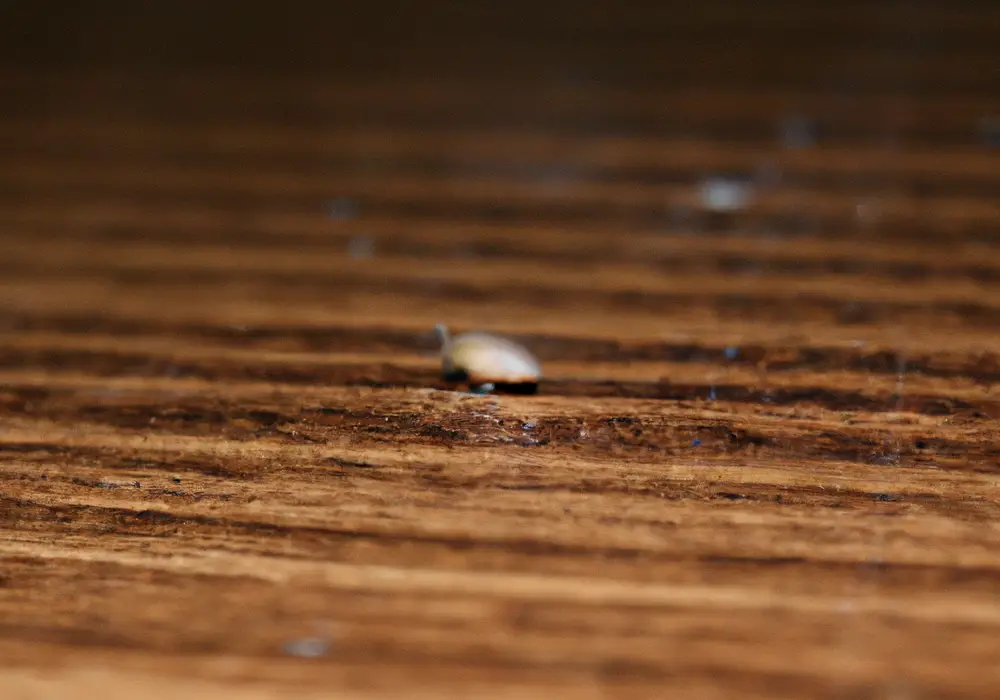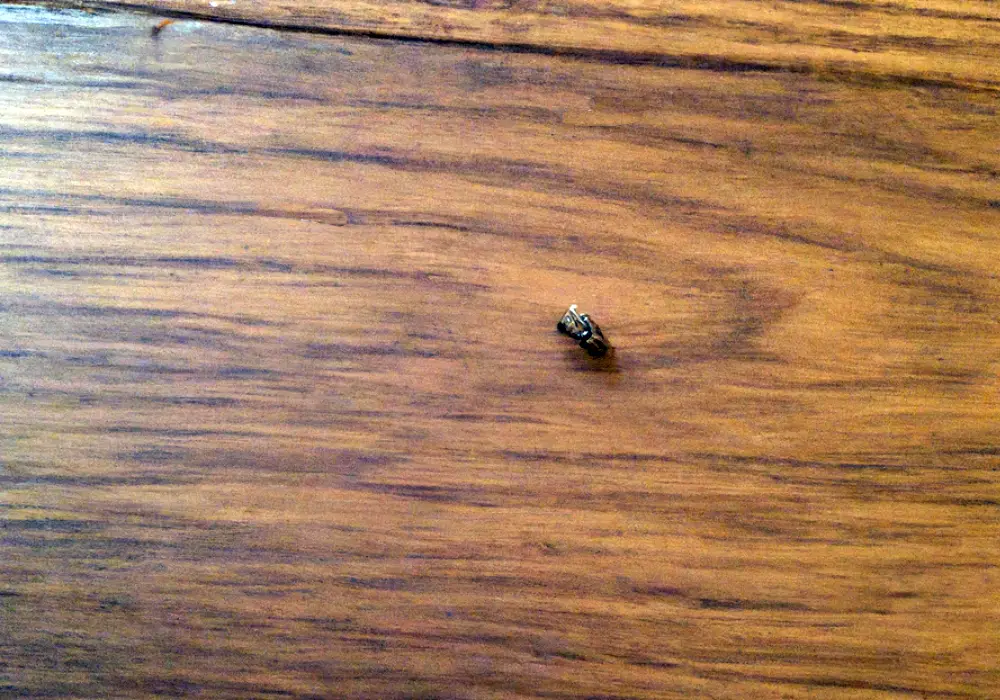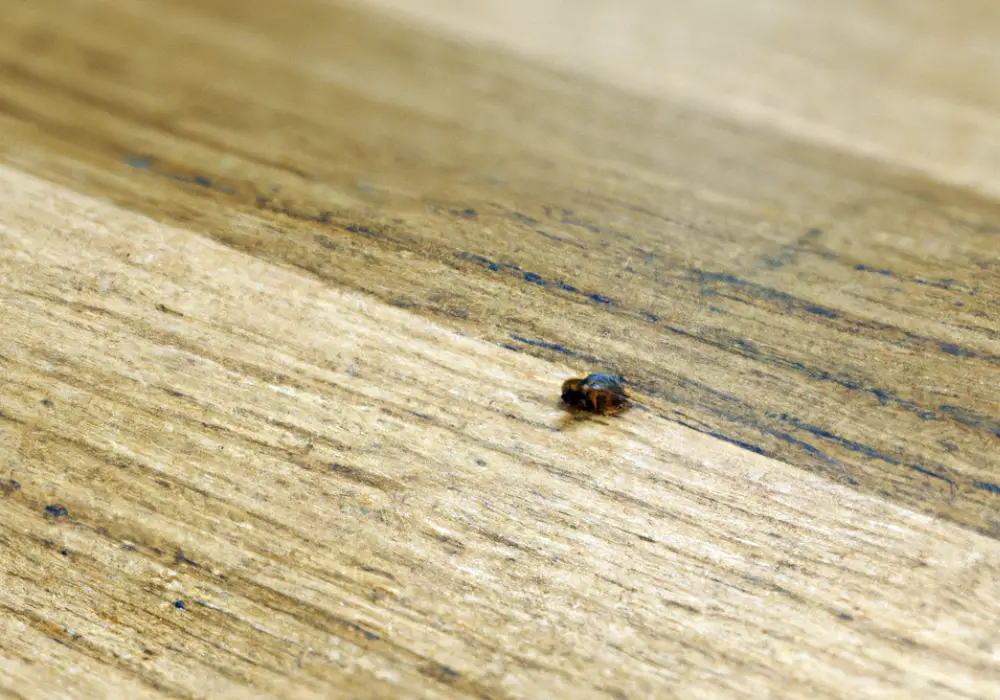Fleas can enter your home in a variety of ways and, once inside, can be a real headache to get rid of. It can be hard to even identify these little pests, and once you know that fleas are all around, they have managed to nest everywhere.
Adult fleas are fast and lay hundreds of eggs resulting in tons of new generations every 10 days or so.
Key Points:
- Fleas can live on and under hardwood floors in areas with minimal traffic and frequent human interruptions.
- Signs of a flea infestation include visible eggs, flea dirt, and bites.
- To get rid of them, furniture must be removed and cleaned, vacuumed floors, and use pet safe flea repellant.
Worse than that, flea eggs can be found on any surface in your home, including hardwood floors. But just seeing flea eggs and flea activity doesn’t mean that they can actually survive there long term, does it? Are fleas able to live on a hardwood floor for long? Let’s find out.
Are Hardwood Floors a Good Flea Habitat?
The surface of a hardwood floor is an extreme environment subject to traffic temperature and multiple cleaning products. Fleas on hardwood floors would not last long unless they are able to find some sort of shelter or reprieve from the exposed conditions
When we try to get rid of fleas on hardwood floors, they will likely slip into nooks, cracks, and gaps in our floors.
Once safe inside the gaps, dust and clumps of flea dirt can be used to feed new generations of fleas and keep the pest problem going until a thorough flea treatment is implemented.
Due to the nature of floor designs, fleas may have access to crawl spaces or other potential breeding grounds deep inside your house’s interior that will require intensive flea fogging to kill. Fleas can live on hardwood floors or at least under and inside of them.
How Long Can Fleans Survive on Wooden Floors?

The length of time a flea can spend on hardwood floors depends on whether the room is occupied, how often it is cleaned, and if a pest control method like diatomaceous earth is implemented regularly.
If you have hardwood floors in a room that seldom has company, then the chance that adult fleas and other insects will have made their home there is likely. If it is a well-used and cleaned floor, then fleas can not survive on the surface.
Chemicals that penetrate under the wood and into cracks can keep these same fleas from fleeing when you clean and return when the coast is clear. Make sure not to use any powder or solution that will stain or damage the wooden floors in your attempt to get rid of fleas in your home.
The more special attention you give your wood flooring, the easier it will be to eliminate signs of fleas.
Signs Your Hardwood Has Fleas
Signs of an infestation can be quite subtle, but if you know where to look, you can help avoid the problem from spreading across the entire floor or throughout the whole house.
Before running to buy a flea fogger or other flea killers and suitable product for hardwood floor protection, you should check out signs to see where the infestation is and how bad it has gotten, especially when you keep getting bit by fleas.
Check out some of the signs of flea infestation in the chart below and see what it means for your home’s control method process.
| Sign | Where to Look | What It Means |
| Flea Movement | On flat white surfaces with good natural light | Fleas have gotten or been brought inside and are either trying to find a place to hide or lay their eggs |
| Flea Feces | While vacuuming carpets and other deeper fabrics, keep an eye out for indications of more dark specs than usual | Fleas are living and eating in your fabrics and on your floors, and this could be the beginning of an infestation |
| Flea Eggs | Corners, wall cracks, and carpets, as well as upholstery, can all have flea eggs on them | Flea larvae can be sustained, and female fleas have access to water and blood needed to reproduce this is evidence of flea activity and multiple generations in your home |
| Flea Nests | Dark corners and underneath upholstered furniture are common places to find dead fleas, flea eggs, flea droppings, and flea activity, all in the same area | An infestation of fleas has occurred, and the complete flea life cycle can continue uninterrupted unless treatment like a flea bomb is used |
How To Kill Fleas In Hardwood?
If you have noticed fleas all over your hardwood floor, you will want to act quickly to stop all adult fleas and baby fleas from spreading. There are many effective flea treatments that can kill fleas and stop the development of flea eggs.
Finding a pet-safe flea spray that won’t harm your wooden floor and will prevent you from being bitten by fleas can be tricky. Creating a system to remove all the fleas and then protecting your area with an efficient flea repellent is the way to go.
Remove Furniture and Furnishing
Any fabric, linens, or removable covers on furniture should be removed from the room you are treating. Clean all of these materials with hot water in the washing machine or a steam cleaner and let them sit in direct sunlight for several hours where possible.
Keep all of these fabrics isolated from anything that is still potentially contaminated by fleas to prevent re-infestation.
Vacuum
The best way to get rid of fleas is to remove as many of the egg-laying adults as possible by vacuuming. Using a vacuum and then getting rid of the bad or spraying a flea killer into the compartment can help you wipe out large numbers quickly.
The more vacuuming you do, the more fleas you will suck up, and the better chance your first complete coverage treatment will be successful.
Sprinkle Diatomaceous Earth
A quick way to treat floors for fleas is with natural insecticide powders like DE and boric acid. If you sprinkle these powders and let them sit for several hours or overnight, you will kill any fleas that come in contact with it. This is a quick and toxin-free way to treat a room while you are taking care of other areas of the home and can greatly slow re-infestation from room to room.
Vacuum Again
Once you are ready to complete the floor treatment, vacuum up any dead fleas and remain powder to prevent stains or other issues when moving on to the next step. Some of the powder will likely stay embedded in nooks and crannies and can work as a pest repellent for a long time.
Mop with Essential Oils
Pine oil and eucalyptus oil are good examples of essential oils with natural pest-killing capabilities that do well for hardwood floors’ shine and luster. These essential oils will penetrate into the wood and kill any hiding fleas, eggs, or larvae that are still alive.
Once the floor has dried, the pleasant aromas of the oils will linger and provide further pest control.
Replace Flea-Free Furniture and Fabrics
Once all signs of flea infestation are gone, you can bring the cloth materials back into the room and reassemble the furnishings. This is a good time to spray a repellent on the floor for fleas and use any flea-premise spray you have to prevent them from coming back or entering from other infested rooms in the house.
Will a Flea Infestation Grow on Hardwood Floors?

It is unlikely a flea infestation will grow on hardwood or tile flooring as there are fewer places to hide and find food sources. However, a floor that is not cleaned regularly or well with a powerful vacuum and hot, soapy water could become a breeding ground for fleas.
Underneath hardwood floors and the gaps by walls is a viable location for fleas to live and grow and can be harder to keep clean than the open floor in the middle of the room.
What Shouldn’t You Use To Kill Fleas on Hardwood Floors?
Even. if products like bleach and ammonia have lethal effects on fleas, it is not wise to use any product on your hardwood floor that could damage or weaken it.
Overly caustic chemicals can cause abrasions that could become new hideouts for insects once the lingering effects of the products are gone. Anything that scratches, increases the flammability of wood floors, or will not dry well on its own should not be used for flea control methods on hardwood floors.


